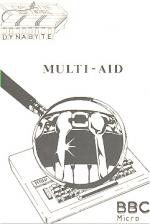
Acorn User
 1st September 1984
1st September 1984
Multi-Aid
Multi-Aid consists of three utility programs, chained from an initial index program. The utilities are 'Character', 'Soundlab' and 'Graph7', each of which will be dealt with individually. The package comes with a small but comprehensive and simple booklet, and two function key strips.
'Character' is a useful utility for creating multi-coloured, simple or multiple characters, and can be used in all BBC graphics modes except mode 7. You first select the foreground and background colours from a menu of eight colours. Modes 1, 2 and 5 allow three foreground colours and the other two-colour modes allow only one.
You then choose the size of the character you wish to create in multiples of the standard 8 x 8 pixel block. This will of course depend on the mode selected, as explained in the booklet; for example, in Mode 2 you can create characters of up to 2 x 3 blocks. Having selected this you then define the ASCII code for your first character (between 128 and 255) and you are then ready to begin.
To create a large number of multiple characters you will need to use non-standard ASCII codes and will require to explode the character set memory before starting. The use of *FX20 to do so is clearly explained in the booklet.
The next step is to select the option to define new characters or edit existing ones. In either case, each character is displayed normal size, and eight times normal for working on. All you now need to do is move around the display area using the cursor keys and set the pixels as required using the function keys for the desired colour.
Another useful function controlled by these keys is the ability to copy a character, simple or multiple, to the next equivalent ASCII codes/memory area, effectively duplicating it. You can then carry on editing to make minor alterations for, say, animation, and avoid recreating the whole character. Similarly, you can list the resulting VDU23 statements, each of which also illustrates the character, and *SPOOL them to use in programs.
The booklet also explains how to recombine the VDU commands into the whole characters within any program. One criticism is that you are not able to use flashing colours. Another is that if you totally 'fill' the memory, you get a 'Too few characters left' message, from which you have to escape and re-run the program. However, you don't lose any of the work you've done as long as the same parameters are used.
'Soundlab' is a comprehensive utility for exploring sound and envelope commands by creating or editing your own commands or using the examples provided. It allows up to seven envelope and nine sound commands (including channel 0). The facilities for editing (including any one of the seven sound parameters individually), playing sounds singly or in sequence, killing a sound, altering any parameter whilst a sound is actually playing and so on, make it a very flexible utility. As with the 'Character' routine, all the created commands can be listed and incorported in your own program.
'Graph7' is yet another Mode 7 screen generator for creating text, graphic or combined teletext screens. It makes use of the function keys on their own and in conjunction with the CTRL and SHIFT keys. Once you get the hang of it, it's quite easy and efficient. Special functions allow you to save up to 24 screens in memory at one time, and to switch between them. You can also *LOAD previous screens to look at or edit, and SAVE or SPOOL any screen to include in your own programs.
The package requires the 1.2 OS, but will work with either Basic. I would class it as one of the better utilities available: it is comprehensive and good value for money. If you do not already have any of these facilities, this is one I would definitely recommend.
Scores
BBC Model B Version| Overall | 84% |





